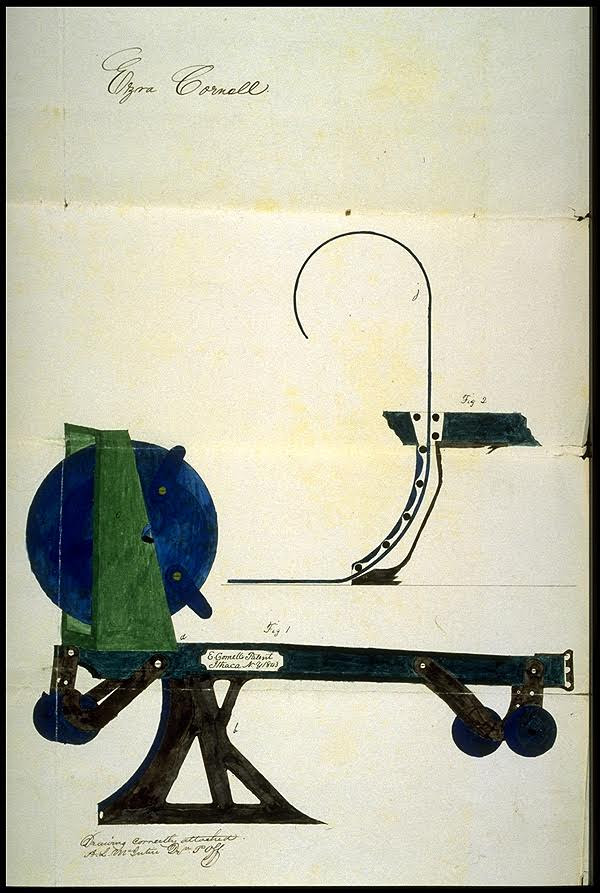While the agricultural land grant university endowed by Ezra Cornell may be the legacy the world remembers him by, his journey from being a farmer, carpenter, salesman, inventor, entrepreneur, politician and most importantly, philanthropist leaves no doubt about the mark he left on society. While he referred to himself simply as a farmer and mechanic his story goes much deeper than that. In fact, it as on this day in 1868, Ezra Cornell’s vision of founding an institution where all persons can be instructed in any area of study came into being as Cornell University inaugurated its first class of students.
Most are unaware that Cornell’s big fortune was created as an associate of Samuel Morse and being the president of Western Union. Ezra Cornell was born at Westchester Landing, New York, the oldest of eleven children, attended village schools along with helping his father’s farm and also learning carpentry. He would leave home at 18, moving to Ithaca, NY where he found work as a machinist, before becoming the manager of the Beebe flour and plaster mills. Soon after, Cornell got married and had children. With no college education, Exra knew he needed to make more money for the family. When the mills he worked at were sold in 1841, Cornell secured the rights to promote a patented plow, which led to a meeting with F. O. J. Smith, a congressman from Maine and a partner of Samuel Morse. Smith had contracted with Morse to lay the cable for an experimental telegraph line from Baltimore, Maryland to Washington and was struggling to design a plow that could do the job. Cornell stopped by Smith’s office in 1843 and promptly sketched a machine that would dig the underground trench and lay and bury the cable in one operation. Smith immediately hired Cornell to supervise the construction of the line and his new plow was a huge success. Unfortunately, the underground line they laid failed as it wasn’t insulated properly, but Cornell was quick to convince Morse to string his lines overhead on poles.
Cornell’s fortune in the telegraph business as an associate of Samuel Morse was primarily driven by his having gained Morse’s trust after constructing and stringing the poles for the Baltimore to Washington telegraph line, the first telegraph line of substance in the US. Interestingly, to address the problem of telegraph lines shorting out to the ground, Cornell invented the idea of using glass insulators at the point where telegraph lines are connected to supporting poles and it wasn’t long after that Cornell was made President of the company. In the early years of the telegraph industry in America, the story was much the same as all nascent industries, meaning many companies were formed, operated briefly, and died. Stronger companies managed to survive.
It was in 1851 that the New York & Mississippi Valley Printing Telegraph Company was organized in Rochester with the goal of creating one great system with unified and efficient operations. At the same time, Cornell had bought back one of his bankrupt companies and renamed it the New York & Western Union Telegraph Company. Originally fierce competitors, by 1855 both groups were finally convinced that consolidation was their only alternative for progress and the newly merged company was named “The Western Union Telegraph Company” at Cornell’s insistence. As Western Union rapidly expanded operations to most parts of the United States and Canada, Cornell would take a lesser active role but would hold on to his Western Union stock for many years.
A couple of interesting facts I had never heard regarding the early days of Western Union include… Western Union sponsored an expedition to survey a route across Russian-owned Alaska and Siberia and as a result of their negotiating for land rights with the Russian government, Western Union helped broker the sale of Alaska to the United States on March 30, 1867. Then in 1871, the company would make a pivot that continues to this day when they added the ability to transfer money electronically through their services. As the business grew, they revolutionized how international money transfers work, and in 1914 Western Union introduced the “Metal Money”, one of the first consumer credit cards. And in 1989, the company made paying bills easier by enabling customers to use Western Union to pay for auto loans, mortgages, and other bills from thousands of businesses.
Cornell eventually retired from Western Union and turned his attention to his greatest passion, philanthropy, which he began by endowing the Cornell Free Library, the first public library for the citizens of Ithaca. More importantly, as a lifelong enthusiast for science and agriculture, he saw great opportunity in the 1862 Morrill Land-Grant Colleges Act to found a university that would teach practical subjects on an equal basis with the classics favored by more traditional institutions.
Cornell would offer his farm in Ithaca, New York, as a site and $500,000 of his personal fortune as an initial endowment. Today, Cornell’s College of Agriculture and Life Sciences, one of the seven undergraduate colleges at Cornell University, is regarded as one of the best of its kind in the world. It’s worth mentioning that it is also the only college of agriculture and life sciences in the Ivy League as well as the second largest college at Cornell. I’d say Cornell gave it his all and left nothing on the table as far as being an example of what can be accomplished if you are willing to do the hard work, take some risks, catch a few breaks and pay attention to the changes happening around you. (Sources: rmc.library.cornell.edu, madehow.com, wiki.com)







